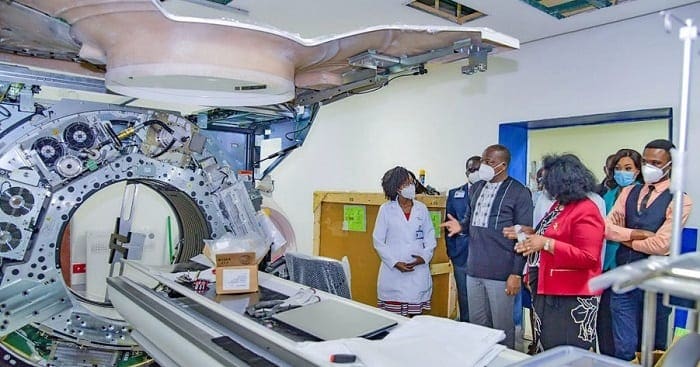Seeking Treatment Abroad: Over 10,000 Kenyans travel Abroad each year

Three days after Jason Njue’s seventh birthday, the bloom that had come with turning a year older soon became gloom.
It was a casual Saturday as he played with his brother when he got off his bike and ran towards his parents’ house complaining about an unusual pain behind his jaws. His mother thought nothing of it.
The pain did not subside, and he kept nagging his mother about it.
The following day his father took him to Gertrude’s Hospital in Kitengela where he was diagnosed with anaemia. “He kept complaining. When his father came home over the weekend, we took him to hospital for a check-up,” says his mother Jackline.
At the hospital, the doctors also noticed that his white blood cells had multiplied, alarming his parents. “Jason was scheduled for more tests. We were referred to Nairobi Hospital,” says the mother.
It was the beginning of a series of check-ups for their son, whose jaw pain did not go away.
At Nairobi Hospital, they saw a haematologist who did more blood tests and a chest X-ray.
While waiting for the results at Nairobi Hospital, they received an email from Gertrude’s Hospital in Kitengela.
“The email said Jason’s blood had been found to have leukaemia cells. But they did not narrow it down to the type of leukaemia he had,” explains Jason’s mother.
At Nairobi Hospital, the results were clearer and Jason was diagnosed with lymphoblastic leukaemia.
At the time, Jason’s pain was not only in the jaws but also in his right leg.
Spreading fast
Nairobi Hospital referred them to Aga Khan University Hospital as they did not have all the equipment needed to tell what subtype of leukaemia Jason had.
Aga Khan conducted another round of blood tests. “We had not secured admission at Aga Khan, so went back to Nairobi Hospital since the pain in his leg was excruciating and he had to be monitored keenly. The doctor had also warned us that the extreme pain meant the cancer was already spreading and we needed to act fast,” Jackline tells HealthyNation.
Unfortunately, Nairobi Hospital sent them back to Aga Khan which was better equipped to handle Jason in case of an emergency.
That was the start of their journey in and out of hospitals in Kenya. “When the Aga Khan results came out, they showed Jason not only had acute lymphoblastic leukaemia but also acute myeloid leukaemia, a type of cancer of the blood and bone marrow with excess immature white blood cells,” says the mother.
By then he had started experiencing pain below his ribs. Doctors at Aga Khan started him on pain medication. They also realised that his platelets were quite low and the white blood cells had tripled since his visit to Gertrude’s.
He urgently needed a blood transfusion to boost his platelet levels. That together with some more pain medication.
Jason was discharged but only stayed home for a week.
While he was at home, the doctors at Aga Khan were deliberating on how they could handle his situation because having two types of leukaemia was unique.
“When we went back to the hospital, doctors decided to go the longer route, handling one cancer at a time. But, one of the doctors advised us to seek treatment outside the country,” she recalls. “The doctor also told us that even if we chose to stay and get treatment at Aga Khan, the machines they had at the hospital lacked the capacity to tell if the cancer had gone to remission (when cancer cells start dying) or not.”
A bone marrow transplant can only be done when there is remission.
India was their next destination for treatment. “We got an agent who connects patients to India. They helped us in looking for a good hospital, accommodation and all the preparations we needed,” says Jackline.
When she spoke to HealthyNation from India, the blood tests had revealed that the cancer cells were not visible in the spinal fluids. “The good thing is that it has not spread to the brain and spleen and we are looking forward to starting chemotherapy. After that, a bone marrow transplant will be possible. Unfortunately, the procedure is not possible in Kenya,” she says.
The family was asked to have at least Sh10 million to be spent for the six-month treatment plan in India. In one month, they had spent Sh1.5 million.
In Kenya, getting proper treatment is costly. Unfortunately, most Kenyans are struggling to get treatment abroad thinking it will be cheap.
A majority of Kenyan hospitals are poorly equipped to provide treatment. Charges at the facilities with the machines are usually extremely high.
The average cost of treating cancer in the country ranges between Sh160,000 and about Sh1 million, depending on the hospital. Faraja Cancer Support, an NGO that works with cancer patients, says this cost is way beyond many Kenyans’ reach.
Worse still more Kenyans are getting diagnosed with cancer, the third leading cause of death after infectious and cardiovascular diseases.
No guarantee
From 2012 to 2018, the annual incidence of cancer increased from 37,000 to 47,887 new cases. During the same period, annual cancer mortality rose almost 16 per cent, from 28,500 to 32,987.
The World Health Organization reckons that of the approximately 41,000 Kenyans diagnosed with cancer annually, about 28,000 die.
However, the public hospitals that are majorly frequented by Kenyans are overstretched and poorly equipped. This is the reason thousands of Kenyans travel to India, South Africa, UK, US and others to seek specialised treatment in areas such as oncology, cardiac surgery, advanced neuro-spine surgery, transplant surgery, and assisted reproductive technology, spending millions of shillings.
More than 10,000 Kenyans travel abroad each year for treatment of various ailments, especially cancer. Government data shows that this costs Kenya about Sh15 billion annually.
Daniel Yumbya, Chief Executive Officer of the Kenya Medical Practitioners and Dentists Council, said going abroad for treatment is no guarantee for better health care.
“Whereas the treatment expenses overseas in some cases may appear pocket friendlier than in Kenyan hospitals, many patients travel oblivious of a myriad of added costs resulting from travel,” says Dr Yumbya, also a management committee member, International Association of Medical Regulatory Authorities.
Besides the hospital fees, patients pay for accommodation, air tickets and food as separate bills. In most cases, family members accompany the patients, adding onto the costs.
Seek approval
“Such costs make treatment abroad extremely expensive and many patients, unable to meet these expenses, end up detained in foreign hospitals for unpaid medical bills. This only adds to the suffering of families already strained by medical bills and anxiety over the health of their members,” he adds.
He says after treatment a patient needs to plan for any necessary aftercare upon returning home.
“One must talk to their doctor to plan for medication and other post-operative needs that may arise from treatment. It would be quite difficult for a practitioner abroad to physically follow up on a patient who sought treatment from them,” This will again cost money,” he says.
For these reasons, in 2017 the council developed rules for referral of patients abroad.
Under the rules, a medical or dental practitioner may refer a patient for treatment abroad where there is evidence of inadequate expertise or medical facilities to handle the condition locally. It can also be done when referral is the most cost-effective option for the patient; and when the patient opts to pay for medical intervention abroad.
The rules determine the procedure for referrals and eliminate sporadic or unwarranted referrals that fleece Kenyans. This means that Kenyans who want to seek treatment abroad must inform the Health ministry and the council.
“This is important because it will help reduce unnecessary referrals when the services can be received in the country at a lower cost. In the unfortunate event a patient loses their life while receiving treatment abroad, the Kenyan Embassy at the country where one is seeking treatment is in the know of such an eventuality, making it easier to help in the transfer of a body,” he says.
In 2019, more than 400 patients were cleared by the ministry and the council to travel abroad for treatment. The numbers recorded in 2020 are slightly lower due to the lockdown imposed to prevent the spread of Covid-19.
The few patients who seek clearance from the council are those who need the National Health Insurance Fund (NHIF) to help with their medical bills abroad.
Hundreds of other people, especially those with private insurance, go directly without the council’s authorisation.
According to the data from the council, the most common referrals are those seeking oncology, heart disease and organ transplants services.
Only two public hospitals — Kenyatta National Hospital (KNH) and Moi Teaching and Referral Hospital in Eldoret have comprehensive cancer treatment facilities in the country. But the long wait, expensive cancer treatment and late diagnosis make it impossible for people to get treatment on time.
Aga Khan University Hospital, Nairobi is the only private hospital in East Africa with a comprehensive cancer centre though many cannot afford it.
Cancer patients all over the country flood the facilities to get affordable radiotherapy and chemotherapy sessions. But they can sometimes wait almost a year for an appointment due to a backlog.
Reduce cost
A survey in three cancer centres in Nairobi including Kenyatta, Nairobi Hospital and Aga Khan revealed deep financial strain for households with patients suffering from cancer.
It costs between Sh172,000 and Sh759,000 to treat cervical cancer without surgery in Kenya and Sh672,000 to Sh1.3 million if one undergoes an operation, according to researchers affiliated to the National Cancer Control Programme and the National Cancer Institute, Kenya.
However, all hope is not lost. With the establishment of East Africa’s first ever public comprehensive cancer diagnostics and treatment centre at the Kenyatta University Teaching and Referral Hospital, to be launched next month, cancer diagnosis and treatment will be faster and cheaper.
The referral facility has spent Sh8 billion to build and equip a state-of-the-art cancer centre with a 650-bed capacity.
The Integrated Molecular Imaging Centre will majorly focus on offering comprehensive early diagnosis, treatment and management of cancer while making the treatment more accessible for patients and lower the cost of PET scans by half.
Currently, it costs roughly Sh75,000 for a PET scan in the private sector. Lack of PET scan machine used to detect cancer and the stage of the disease is one of the reasons patient travel abroad. The facility can scan 60 cancer patients per day.
Since the launch of the hospital in October 2019, over 5,000 cancer out-patients and 1,000 in-patients have been attended to in the facility. More have booked.
Already, the centre has installed a 256-Slice CT scanner and 3T MRI. The hospital’s main goal is to provide survivorship and fill the gaps in the region in terms of screening, diagnosis and treatment.
The 256-slice CT scanner can give cardiologists a picture of the human heart and is now being used to diagnose heart disease. The 3T MRI has a stronger magnet and makes better images of organs and soft tissue than other types of MRI do.
“The centre will also address the gap of lack of efficient cancer screening and diagnosis in the East African region,” says Dr Sarah Osiemwo, the head of radiology department at the hospital.
Through the American Conglomerate, General Electric Healthcare, the centre has since brought molecular imaging equipment including a positron emission tomography-computed tomography (PET-CT) scanner.
A PET-CT scanner is an imaging tool that combines two scanning techniques, allowing doctors to see any changes in the activity of cells and where they are taking place.
The machine gives an accurate indication of the progress of the disease in its earliest stages. It will also scan and detect the location and extent of cancer that has recurred after initial treatment and spread.
As well as attracting patients from outside the country, the hospital has also built a ‘hostel’ where patients will live as they undergo treatment at the hospital.
Jason’s parents are only hoping that with the establishment of the facility, the treatment they need will reach them in time.
The centre will house the cyclotron machine whose key function is to produce radio isotopes (consumables) that are used to prepare dosage that is injected into the patient for early diagnosis of cancer through the PET-CT machine.
Proper diagnosis
A cyclotron is a type of compact particle accelerator that produces radioactive isotopes that can be used for imaging.
The isotopes that are currently being used in the country for cancer treatment are always imported machine in place. Kenya will be able to locally manufacture consumables, and this, is expected to bring down the cost of healthcare.
The electrically-powered machine does this by producing a radioactive sugar tracer (called 18F-FDG) that is metabolised by cancer cells, thereby highlighting the sites of the disease and its extent and/or spread. The isotopes are also used to monitor remission or progression of cancer.
The 18F-FDG tracer is administered as an injection and is used a PET scan to help doctors diagnose cancer, heart disease, and epilepsy. Areas that use more energy pick up more of the sugar. Cancer cells tend to use more energy than healthy cells. The PET scan shows where the radioactive tracer is in your body.
“This cyclotron will be the first public facility and the largest in Eastern and Central Africa, with a capacity to produce consumables for domestic use and for the region,” said Health Cabinet Secretary Mutahi Kagwe.
The equipment, key in producing the radioisotope tracers, is also expected to produce the consumables for other hospitals across the country.
The isotopes in a cyclotron can be used to check how far the cancer has gone at the first stage of diagnosis and during treatment, to check the progress and whether some of cancer cells are dying –remission. Jason’s parents had to travel all the way to India to get this service.
“Kenya has extremely low levels of PET/CT and SPECT/CT penetration and less than 20 radiotherapy equipment across the country,” he said.
The availability of the machine, the second in the country, is expected to reduce the number of people travelling out of the country for cancer treatment.
FACT BOX
What is medical tourism?
This is when a person seeks medical attention in a country other than their own.
Why do people do this?
- Expertise that could be unavailable in their country
- Cheaper costs for treatment
- Diversifying treatment
- To keep their medical issues private
- Long waiting time for treatment
Downside of Medical Tourism
· Expenses can be costly to some people
· Risk of getting infectious diseases in the country of visit
· Communication barrier
· Risk of not getting continued quality care after returning to your country
· It can lead to antibiotic resistance
· Traveling by air after surgical procedures could lead to further complications
What you need to do
· Consult with your doctor and travel medicine provider a month before travelling
· Get an international travel insurance
· Plan on what activities to refrain from doing before travelling
What procedures do Kenyans seek abroad?
- Heart procedures
- Nephrology
- Oncology
- General surgery
- Dental surgery
- Orthopaedic surgery
- Neurological surgery
- Plastic surgery
Destination countries of most Kenyans
- India
- South Africa
- US
- UK
- Philippines
- Pakistan
- Israel
- Jordan
By Angela Oketch & Hellen Shikanda
Source-https://nation.africa/
Seeking Treatment Abroad: Over 10,000 Kenyans travel Abroad each year.







